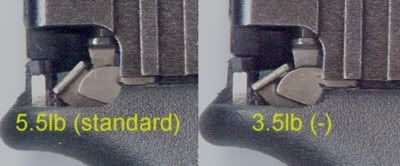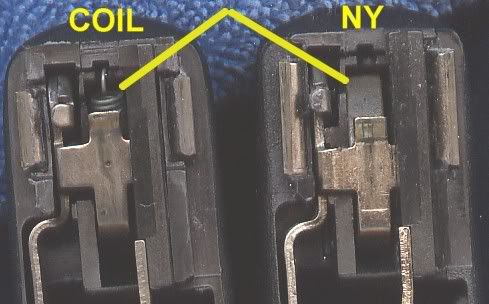
 |
|
|||||||
| Forum Rules | Firearms Safety | Firearms Photos | Links | Library | Lost Password | Email Changes |
| Register | FAQ | Calendar | Today's Posts | Search |
 |
|
|
Thread Tools | Search this Thread |
|
|
#1 |
|
Member
Join Date: April 8, 2008
Location: Seattle
Posts: 99
|
Glock Trigger Connector 101
Can anyone explain what the trigger connector in my Glock does?
I suppose there are connectors in other guns as well, but I am a Sig, 1911, and CZ man traditionally (forgive me if these have an identical part, but I've taken these down to springs and pins as well and there doesn't seem to be a "connector". I assume it's a striker thang.) I like to have a grasp on how my pistols function and this is the one part that I haven't quite figured yet. I know how the slide interacts with it on recoil and that it is capable of stoping rearward motion of the trigger bar, but only slightly, as the bar is almost all the way back at that point. Any experts here? For some reason I'm banned from GLOCKTALK.com  Ive never even been a member... Ive never even been a member...
|
|
|
|
|
#2 |
|
Senior Member
Join Date: February 15, 2010
Location: Louisville Ky.
Posts: 137
|
Are you refreing to the connector that runs along the frame of the gun from the trigger to the rear of the gun? If so it conects the trigger to the trigger housing and the nub you see sticking up half way down the bar is to depress the safty plunger so the sear pin can move foward far enough to hit the primer. Otherwise the safty plunger will block the sear pin from its full travel as its desighned to so. other than that its the same function as any other connector you might find in any other gun. IM not familier with other gun as well as I am glocks. If im awnsering the wrong question then im sorry im misunderstanding the question.
__________________
The most powerfull weapon a person owns is in their own brain 
|
|
|
|
|
#3 |
|
Senior Member
Join Date: December 26, 2004
Location: Louisville KY
Posts: 13,806
|
Easy. Take the slide off, pull the trigger and watch what the action does at the very back-right. You'll see what the connector does at that point.
BTW the section that is part of the trigger is the bar. The connector is a very small piece at the back, the diagonal piece in the picture.  Uploaded with ImageShack.us |
|
|
|
|
#4 |
|
Senior Member
Join Date: September 13, 2007
Location: Sunny Florida
Posts: 844
|
The connector moves the sear down, out of engagement with the striker, after the sear has pulled it back. Different connectors have different angles, which is why you can drop them in and change trigger pulls. They drop the sear down earlier or later in the trigger pull. Some brands of aftermarket connectors have a trigger stop, an extra projection on the connector that an armorer can file away until there is just enough room for the sesr plate to fall before rearward movement of the trigger stops.
There really isn't a similarity to your 1911s or CZs. Different system. |
|
|
|
|
#5 |
|
Member
Join Date: April 8, 2008
Location: Seattle
Posts: 99
|
very good, I see. I was almost certain of that part of its function. I also would like to know something else about it. When I remove the slide i notice that the connector rests on top of the trigger bar. if i move the trigger bar forward it will snap back into line behind it. What is the function, if any , of this? Also, and this is probably related, what does the ear on the top of the connector do? I know it is moved by the slide at some point, but why?
|
|
|
|
|
#6 |
|
Member
Join Date: April 8, 2008
Location: Seattle
Posts: 99
|
Nevermind. This is like a disconnector. The only way you could have the trigger pulled to the rear while the striker is still held back is to force the connector (maybe we call this part of the connector the disconector?) to the side and allow the trigger bar to come back up.
I officially understand my glock. |
|
|
|
|
#7 |
|
Staff
Join Date: February 12, 2001
Location: DFW Area
Posts: 24,986
|
There's a "ramp" inside the slide of the Glock that flexes the connector over to the left to disengage it from the trigger bar when the slide cycles.
When the connector is flexed to the left it lets the trigger bar pop back up under the pressure of the trigger spring. That disconnects the trigger from the connector which means that the trigger bar will stay in the upward position until the trigger is released far enough forward to allow the connector to pop back over to the right where the trigger bar "cam" can once again engage the lip on the connector. By the way, here's a picture showing two different connectors installed and their relationship to the trigger bar. It will give you a feel for how different connectors change the trigger pull.  Simplified: So, when you pull the trigger it pulls the striker/firing pin to the rear until the trigger bar "cam" (rounded end visible in the photo) engages the "lip/ramp" on the connector which forces the trigger bar downward. The downward motion of the trigger bar eventually takes it out of engagement with the firing pin/striker which releases the striker to move forward and fire the pistol. The force of recoil moves the slide backward which causes the "ramp" inside the slide to exert pressure that flexes the connector to the left and takes the "lip/ramp" of the connector out of engagement with the trigger bar "cam". The trigger bar springs upward under the force of the trigger spring which puts it in position to catch the firing pin/striker when the slide comes back forward. With the trigger bar fully to the rear and in the upward position, it blocks the connector from springing back to the right so the connector stays flexed to the left. This picture was taken to show the difference between the NY and coil trigger springs but it also shows the two different relationships between the trigger bar cam and the connector lip.  In the picture on the right the connector is in the "fire" position and pulling the trigger would fire the gun if it were properly assembled. In the picture on the left the connector is in the "fired" position and the trigger bar is resting next to it preventing it from snapping back to the position it normally occupies. (Before I catch any heat for posting a picture of dirty guns, the "gunk" in the picture is actually a very light grease made from ultra fine moly powder mixed with CLP.) The trigger bar stays in the up position held back by the shooters finger and upward by the trigger spring until the shooter releases the trigger sufficiently to let the connector snap back over to the right. That puts the "lip/ramp" of the connector back in position so that when the trigger is pulled again the cycle repeats.
__________________
Do you know about the TEXAS State Rifle Association?
|
|
|
 |
|
|